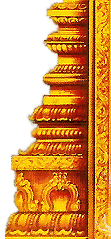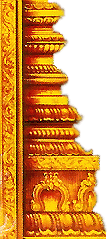A part of Chera kingdom was in fragments during the 9th century and was in a famine condition. Local anti-socials had an upper hand. A robber, Udayan by name demolished the Sabarimala temple, killed the priest and took away the Panchaloka idol of Lord Ayyappa. To protect the land and people of the region Lord Ayyappa incarnated as a warrior. Udayan also robbed the wealth of Travancore palace and attempted to abduct the princess. One Jayandan rescued and married her. Sri Sastha was born to them. The parents named the child Ayyappa. Jayandan taught him all the arts including war craft.
Ayyappa joined the services in Pandala palace. The king was attracted by the intelligence and heroism of Ayyappa. He elevated Ayyappa as the chief commander and then as the heir of his throne. Two commanders Kaduthai and Mallan opposed the proposal. Ayyappa won them and kept them with him. Later, he also defeated a pirate Babar and made friends with him. Besides his excellence in material arts, he was also learned in yoga and was spiritually powerful. He also brought the commander Sirumoorappan to his side. His daughter Sirukoothi wanted to marry Aiayappan who in turn changed her mind and directed her to spiritual path.
Ayyappa decided to capture the robbers in Pandya kingdom who committed thefts in Cherea kingdom. He did not directly clash with the robbers but joined the services of the Pandya king without disclosing his identity and earned the goodwill of the king by his knowledge, honesty, integrity and efficiency. Pandya queen however, suspected him to be a spy. She told Ayyappa that she was suffering from severe headache and asked him to bring the milk of a tiger for cure. Divine Lord Ayyappa, made the Devas tigers and brought them to the king’s palace. He disclosed what he was and demanded a promise from the Pandya king that his viceroys and robbers should not cause troubles to Chera kingdom and that he should help them to manage the situations then if need be. Pandya king was too pleased with Ayyappa’s demand and gave him an honourable farewell.
On return to Pandalam, Ayyappa decided to defeat Udayan hiding in Karumalai and causing threats to the region. He divided the army into three divisions and appointed Kochukaduthai, Vavar and Mallan as commanders. They were advised to undergo fasting in Erimeli, relax by singing and dancing, stay then at Perunthodu, bathe in Azhuda River and perform puja to Lord Dharma Sastha the custodian deity. They were also instructed to reach Karimalai and proceed to destroy the Injiparai Fort and other hide outs of the robbers. After destroying them, the commanders with their army should pass through Periyanai Vattam and Sirynai Vattam and perform the last rituals for the dead soldiers. They were advised to light lamps in the river. They were instructed to pass off Neelimalai, Appachimedu, Sabaripeetam and keep there the remaining weapons.
The commanders were also instructed to pray that a situation of handling weapons should not recur and pass through steps representing 18 philosophies and reach Him. Pandya king realized that Lord Sastha Himself served him in the name of Ayyappan and built the temple at Sabarimala.
T.S. Krishnan.
EMPEROR OF JUNGLES
Achankovil is a holy place next to Sabarimala Ayyappan temple. According to history of the land, Sastha as a youth lived in this place. Sri Dharma Sastha graces here with His consorts Poorana and Pushkala as the protector of people. The temple was built and the deity was also installed by Sage Parasurama, hence has double significance. A 10 day festival is devotionally celebrated here from the first day of Dhanur Masa-Tamil month Margazhi beginning almost on December 15 or a day earlier or after occasionally in some years. The speciality is the boat festival – Teppam – not observed in other Ayyappan temples. Those affected by poisonous bites believe that applying the sandal paste on Ayyappan idol would cure them completely.
NAGARAJA, NAGA YAKSHI
Nagaraja and Naga Yakshi are installed near Basma tank – Basmakulam- near the bathing spot made for the convenience of the devotees. People sing serpent songs here. Those seeking child boon join this worship hoping to be blessed with a child. Devotees offer silk sari, flower, turmeric, kumkum to Naga Yakshi and turmeric and camphor to Nagaraja.
ORNAMENTS TO MAALIGAIPURAM AMMAI
Besides ornaments to Lord Ayyappa in Sabarimala, there are ornaments for Maaligai Puram Amman kept separately in a box and brought to pujas. Pujas are performed here the same time when pujas are performed for Lord Ayyappa. The temple is open for six days after the Makara Jyoti event. It is said that the main deity of the festival of six days is Maaligai Purathu Amman waiting to wed Lord Ayyappa, according to tradition.
AN INSPECTOR
There lived a Good Samaritan Islam gentleman Babar (Vabar) on the way to Sabarimala, but was a robber in trade. He used to rob the pilgrims and distribute the bounties to the poor in the region. The king could not capture him. He appealed to Lord Ayyappa to capture him. Babar did not listen to the advice of Child Ayyappan and therefore, Lord decided to eliminate him. Babar asked Ayyappan who would take care of the poor in the place if he was killed. Lord replied that it would be His responsibility and appointed him as check-post officer-inspector at the spot.
There is a mosque on way to Sabarimala. Devotees visit this mosque. Devotees should promise here that they maintained celibacy (Brahmmacharya) during the season, get Vibhuti Prasad and proceed then to the Sabari shrine
LORD SASTHA LEAVES HIS CONSORT
Mambazhathurai is 20 km from Ariyangavu where Lord Sastha wedded Pushkala. Lord thought that she would be a hindrance to His ideals and made her reside in this place. The Goddess graces the devotees from this place as Mother Bhagavati Amman-Badrakali.
TARPAN AT PAMPA
Devotees perform Tarpan at holy Pampa river. Many reasons are attributed for this practice. Lord Rama performed Tarpan to His ancestors here while on his way to meet Mother Sabari who was waiting to have His darshan before shedding her mortal coil. It is said that devotees are also practicing this ritual now following Lord Sri Rama.
CHIN MUDRA OF LORD AYYAPPA
When sage Parasurama established a temple for Lord Dharma Sastha, there were no roof or compound walls. He installed only the idol of Lord. After His incarnation, Dharma Sastha grew in the name of Ayyappan and performed penance to merge in the idol. He merged in the idol with a Chin Mudra symbolizing the union of Jeevatma (mortals) with Parathma the eternal.
PUJAS IN THE BEGINNING DAYS
In early days pujas were performed at the shrine only once a year on the Makara Jyoti day. Priests were coming from a place called Nilakkal. After the merger of Ayyappa with Lord Dharma Sastha, pujas began to grow in numbers as monthly pujas, Mandala and Makara Vilakku pujas. According to the story of the place, Dharma Sastha is different from Ayyappa.
GARUDA SHOWING THE WAY
The time came when Rajasekharan the king of Pandala, adopted father of Ayyappan also praised as Manikandan had to part with the Lord. He said to his father that He had decided to go to the jungle and that the king would have to come to Him crossing hills and rocky crude routes. The king expressed his feelings of inability and asked for guidance. Lord told him that Garuda the divine eagle and vehicle of Lord Vishnu would escort him during such visits.
The king, during such journeys would sit on the way crying Aiyo Appa an expression of feeling of extreme weariness. These two words combined and the name Ayyappan came into being, according to one story. Even today, when ornaments are being brought to the shrine from Pandala place, an eagle is visibly flying above the group as an escort.
DATE OF PANDALA PALACE
A minister conspired to kill the Pandya king to usurp the throne. The king escaped and reached Kerala. After some years, he bought a piece of land and established a palace. According to history, this might have happened in AD 904. Kings who succeeded the Pandya king later extended the palace and also the state.
BASMA KULA THEERTHAM
Basma Kulam Theertham in the temple is considered very sacred. The water was sweeter than of a green coconut. The very sight of the water would cleanse people of their sins. When crowds began swelling later, the water was highly polluted and the banks of the tank had become a toilet ground. However, the place is cleaned now to certain extent. It is the duty of the devotees to restore the sanctity of this sacred spring. It is suggested that the entrance to the tank should be blocked in such a way that people would be able to have only a few drops of water to sprinkle on their heads.
PHILOSOPHY BEHIND AYYAPPA HISTORY
Sabarimala is a university of philosophical teachings. God blesses every one surrendering at his feet with all prosperity and happiness. The holy mount also reminds that if the blessing of God are misused, punishment too await them. Even those with boons of immortality had to meet with their ends due to sins and arrogance. The one certainty of life is but uncertainty. Once man or woman remembers this truth, they would not have to struggle across the ocean of Samsara again and again. The history of Ayyappa began in a palace. He resorted to a lonely life in the midst of a jungle. What to say about average human beings? To illustrate this truth, devotees go to the shrine in simple uniforms without any discrimination of financial status. Also, we go in groups together, worship the Lord and return with a fund of blessings.
ESSENCE OF MEDITATION IS CONCENTRATION
We see Lord Ayyappa in Sabarimal in a sitting form both His legs bent and pressed on the floor. His dhoti is tied tightly around His knees. This shows His firm concentration in Dhyana-meditation. No occasion should compel Him to get up even if the visitor was His father.
|





